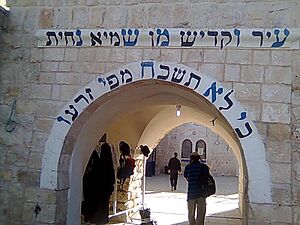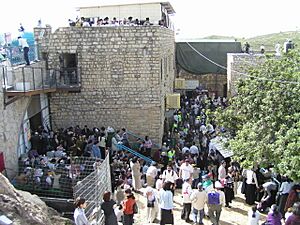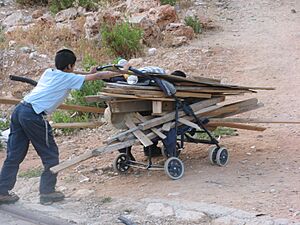Lag BaOmer facts for kids
Quick facts for kids Lag BaOmer |
|
|---|---|
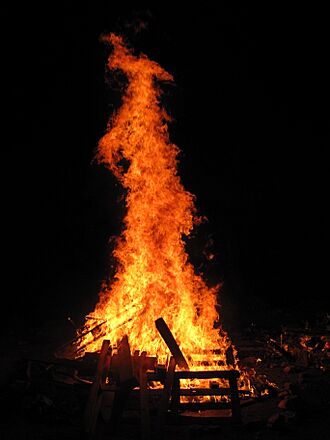
A Lag BaOmer bonfire celebration in Israel, symbol of the holiday
|
|
| Official name | לַ״ג בָּעֹמֶר |
| Type | Jewish |
| Significance | 33rd day of the Counting of the Omer, which begins the 2nd day of Pesach |
| Begins | 18th day of Iyar |
| Date | Lua error in Module:Wikidata at line 132: attempt to index field 'wikibase' (a nil value). |
| 2024 date | Sunset, 25 May – nightfall, 26 May |
| 2025 date | Sunset, 15 May – nightfall, 16 May |
| 2026 date | Sunset, 4 May – nightfall, 5 May |
| 2027 date | Sunset, 24 May – nightfall, 25 May |
| Related to | Pesach, Shavuot, Counting of the Omer |
Lag BaOmer (Hebrew: לַ״ג בָּעֹמֶר, LaG Bāʿōmer) is a fun Jewish holiday. It is celebrated on the 33rd day of the Counting of the Omer. This special day happens on the 18th day of the Hebrew month of Iyar.
Lag BaOmer is a day of joy. It marks the end of a sad time for many Jewish people. This sad time remembers a plague that stopped on this day. The plague had affected 24,000 students of a wise teacher named Rabbi Akiva.
This holiday also honors Shimon bar Yochai. He was a very important Jewish leader and mystic. Many people visit his burial place in Meron on this day. They light bonfires and have big celebrations. In modern Israel, Lag BaOmer also remembers the Bar Kokhba revolt. This was a fight against the Roman Empire long ago.
Contents
What Does Lag BaOmer Mean?

Lag BaOmer means "33rd [day] in the Omer". The word "Lag" comes from two Hebrew letters. The letter ל (lamed) means 30. The letter ג (gimmel) means 3. Together, they make 33.
Some Jewish people say "Lag LaOmer". This means "33rd [day] of the Omer". Others say "Lag BaOmer", meaning "33rd [day] in the Omer". Both ways are correct. They are just different traditions. Ashkenazi and Hasidic Jews often say "BaOmer". Sephardi Jews often say "LaOmer".
The Story Behind Lag BaOmer
The exact start of Lag BaOmer as a holiday is not fully clear. One of the oldest ideas is that it marks the end of a terrible plague. This plague affected the 24,000 students of Rabbi Akiva. The plague stopped on the 33rd day of the Omer. Because of this, the sad period of the Omer ends on Lag BaOmer for many communities.
Another important idea is that Lag BaOmer is the day Shimon bar Yochai passed away. He was a very wise teacher and a master of Kabbalah. Kabbalah is a special part of Jewish wisdom. People believe that on this day, Rabbi Shimon bar Yochai shared deep spiritual light with the world. This is why many people visit his tomb in Meron.
Some scholars also connect Lag BaOmer to the Bar Kokhba revolt. This was a Jewish fight for freedom against the Roman Empire. They believe that the plague on Rabbi Akiva's students was a secret way to talk about the war. Lag BaOmer might have been a day when the Jewish rebels had a small victory.
In Europe before World War II, Lag BaOmer was a special day for students. It was called "Scholar's Day." Students got to go outside and play sports.
Spiritual Meaning
Lag BaOmer has a special meaning in Kabbalah. The Omer count has a spiritual journey. Each day and week has a special quality. The 33rd day is called Hod she-be-Hod. This means "Splendor within Splendor." It represents a high level of spiritual light. This light comes before the full spiritual showing on the 49th day.
How People Celebrate Lag BaOmer
The time of the Omer is usually a sad time. But on Lag BaOmer, all the sad rules are lifted for many Jewish people. This means people can have weddings, parties, listen to music, and get haircuts. Ashkenazi Jews do this on Lag BaOmer. Sephardi Jews usually wait until the next day.
Many families go on picnics and enjoy being outdoors. Children often play with bows and arrows. This is a fun tradition for the holiday.
Bonfires
The most famous custom of Lag BaOmer is lighting bonfires. These fires have a few meanings. They can show the "spiritual light" that Rabbi Shimon bar Yochai brought to the world. They might also remember the signal fires. These fires were lit by the Bar Kokhba rebels to send messages. The Romans had forbidden lighting fires for Jewish holidays.
Around the world, people gather to light bonfires. A very big celebration happens at the Tomb of Rabbi Shimon bar Yochai in Meron. Hundreds of thousands of people gather there. They celebrate with huge bonfires, torches, singing, dancing, and feasting.
Bows and Arrows
Children in Israel often play with bows and arrows on Lag BaOmer. This tradition has a special meaning. It reminds us of a story that says a rainbow was not seen during Rabbi Shimon bar Yochai's life. His special goodness protected the world. The bow and arrow also remind people of the Bar Kokhba revolt against the Romans.
In Israel, Lag BaOmer is a holiday for children and youth groups. The Israel Defense Forces (IDF) also marks this day. The Gadna program, which trains young people, was started on Lag BaOmer in 1941. Its symbol is a bow and arrow.
Parades
The Lubavitcher Rebbe, Rabbi Menachem Mendel Schneerson, encouraged Lag BaOmer parades. These parades happen in Jewish communities all over the world. They show Jewish unity and pride. Chabad groups organize parades, rallies, bonfires, and barbecues for many people each year.
Songs and Meals
There are several traditional songs for Lag BaOmer. People sing them around bonfires and at special meals called tishen. A popular song is "Bar Yochai". It was written to honor Rabbi Shimon bar Yochai. Another song is "Ve'Amartem Koh LeChai".
During a tish meal, people eat a full meal and light candles. They sing the special holiday songs. Rabbis often share teachings from Rabbi Shimon bar Yochai. Sometimes, a three-year-old boy might have his first haircut at a tish. This is a special tradition for young boys.
Lag BaOmer and Zionism
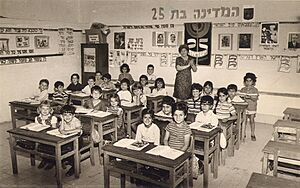
In modern Israel, early Zionists gave Lag BaOmer a new meaning. They focused on the Bar Kokhba revolt against the Roman Empire. They saw it as a day to remember Jewish bravery and fighting spirit. The story of Rabbi Akiva's students was seen as a hidden message about the revolt. The 33rd day, when the plague ended, was seen as a day of victory for Bar Kokhba.
This idea helped to build the spirit of an independent Jewish state. Lag BaOmer became a symbol of Jewish strength. The Palmach, an important part of the Haganah (a Jewish defense group), was created on Lag BaOmer in 1941. The order to create the Israel Defense Forces (IDF) was also given on Lag BaOmer in 1948. Since 2004, Lag BaOmer has been a day to honor IDF reserve soldiers.
See also
- Hebrew numerals
- Jewish and Israeli holidays 2000–2050
- Sephirot, the 10 attributes/emanations found in Kabbalah.
- Significance of numbers in Judaism
- Hillula of Rabbi Shimon bar Yochai


